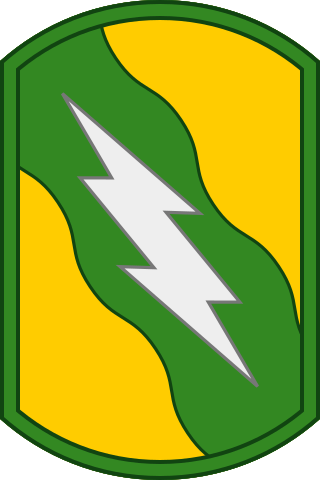
The 36th Infantry Division ("Arrowhead") also known as the "Panther Division", the "Lone Star Division", "The Texas Army", and the "T-patchers", is an infantry division of the U.S. Army and part of the Texas Army National Guard. The 36th Infantry Division was first organized during World War I (1914–1918) from units of the Texas and Oklahoma National Guards. After the war, the division was reformed as an all-Texas unit, and was called to service for World War II (1937–1945) on 25 November 1940, was deployed to the European Theater of Operations in April 1943, and returned to the Texas National Guard in December 1945.

The 4th Infantry Division is a division of the United States Army based at Fort Carson, Colorado. It is composed of a division headquarters battalion, three brigade combat teams, a combat aviation brigade, a division sustainment brigade, and a division artillery.

The 1st Cavalry Division is a combined arms division and is one of the most decorated combat divisions of the United States Army. It is based at Fort Cavazos, Texas. It was formed in 1921 and served during World War II, the Korean War, the Vietnam War, the Persian Gulf War, with the Stabilization Force in Bosnia-Herzegovina, in the Iraq War, in the War in Afghanistan as well as Operation Freedom's Sentinel and Operation Inherent Resolve. As of July 2023, the 1st Cavalry Division is subordinate to III Armored Corps and is commanded by Major General Thomas M. Feltey
The 12th Cavalry is a cavalry regiment of the United States Army. It is currently stationed at Fort Cavazos.
Forward Operating Base Hope is the current name of Camp War Eagle which was the name of the United States Army camp located at the northeast corner of the Baghdad slum known as Sadr City. It was established in May 2003 by 1st Squadron, 2nd Armored Cavalry Regiment and B Company, 2nd Battalion, 37th Armor Regiment which is an element of 1st Brigade, 1st Armored Division. War Eagle was located on the site of a pre-war Iraqi Army base, and as such was walled and somewhat suited for use as a forward operating base.

The 9th Cavalry Regiment is a parent cavalry regiment of the United States Army. Historically, it was one of the Army's four segregated African-American regiments and was part of what was known as the Buffalo Soldiers. The regiment saw combat during the Indian and Spanish–American Wars. During Westward Expansion, the regiment provided escort for the early western settlers and maintained peace on the American frontier.

Below is an estimated list of the major units deployed within the Multi-National Force – Iraq and other United States military units that were operating in Iraq under the U.S. Central Command (USCENTCOM) in 2009, during the Iraq War.

The 3rd Brigade Combat Team, 1st Cavalry Division is a combined arms armored brigade of the 1st Cavalry Division based in Fort Cavazos, TX. Major equipment includes the M1A2SEP Tanks, M2A3 & M3A3 Bradley infantry fighting vehicles, M109A7 Paladin howitzers, and M1114 up-armored Humvees.

The 1st Squadron, 75th Cavalry Regiment is an inactive United States Army cavalry squadron established in 2004. It was the Reconnaissance, Surveillance and Target Acquisition Squadron (RSTA) squadron of the 2nd Brigade Combat Team "Strike" ♥, 101st Airborne Division. It performed reconnaissance and cavalry missions in support of that brigade.
Forward Operating Base Duke is a base of the Iraqi Armed Forces located 20 km northwest of Najaf, Iraq.
Forward Operating Base Iskandariyah (Arabic:إسكندرية), or FOB Iskandariyah, was a United States military forward operating base located on the grounds of the Musayyib Power Plant and the banks of the Euphrates River, north of the town of Musayyib, Babil Governorate, Iraq from 2003 to 2009.

The 32nd Cavalry Regiment is a cavalry formation of the United States Army. From 1941 to 2000, it was an armor formation.
FOB Paliwoda or Camp Paliwoda was a US forward operating base (FOB) in Balad, Iraq. The base was named for Captain Eric Paliwoda, an Engineer Officer and West Point Graduate from Farmington, Connecticut serving with the 3rd Brigade Combat Team, 4th Infantry Division, who was killed in an enemy mortar attack in Balad on 2 January 2004; it had formerly been called FOB Eagle.

The 116th Cavalry Brigade Combat Team is the largest formation of the Idaho Army National Guard. It is headquartered at Gowen Field, Boise, Idaho. It has been reorganized into an Armored Brigade Combat Team (ABCT) but remains the only unit to be designated a "Cavalry Brigade Combat Team" by special appointment of the US Army. The 116th Cavalry Brigade Combat Team has units located throughout Idaho, Montana, Oregon, and Nevada. It was reorganized into a heavy armor brigade in 1989. Often referred to as the Snake River Brigade and formerly known as the 116th Armored Cavalry Regiment, the unit includes about 3,000 citizen-soldiers from Idaho.

The 155th Armored Brigade Combat Team is a brigade combat team of the Mississippi Army National Guard.
Kirkush Military Training Base was a United States Army installation near the city of Balad Ruz in Diyala Governorate, Iraq.

The 1st Battalion, 107th Cavalry Regiment was a unit of the Ohio Army National Guard, with troops in multiple locations throughout northeastern Ohio and has served in the United States of America's major wars and conflicts since 1898 until its inactivation on 31 August 2007.

The 98th Cavalry Regiment is a parent regiment of the United States Army established in 2006. It is represented in the Mississippi Army National Guard by the 1st Squadron, 98th Cavalry, an element of the 155th Armored Brigade Combat Team.

First Squadron, 153rd Cavalry Regiment "Darkhorse" is an element of the Florida Army National Guard, headquartered in Panama City, Florida with units throughout the Panhandle. It was formerly 3rd Battalion, 124th Infantry and officially converted to cavalry on 1 September 2007 when the 53rd Infantry Brigade converted from a "separate brigade" to the brigade combat team structure.














